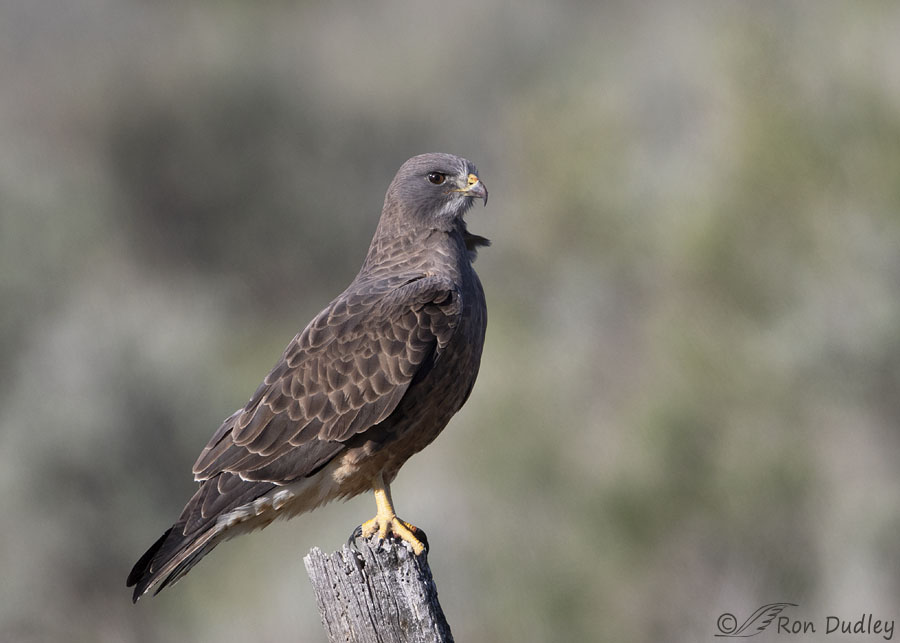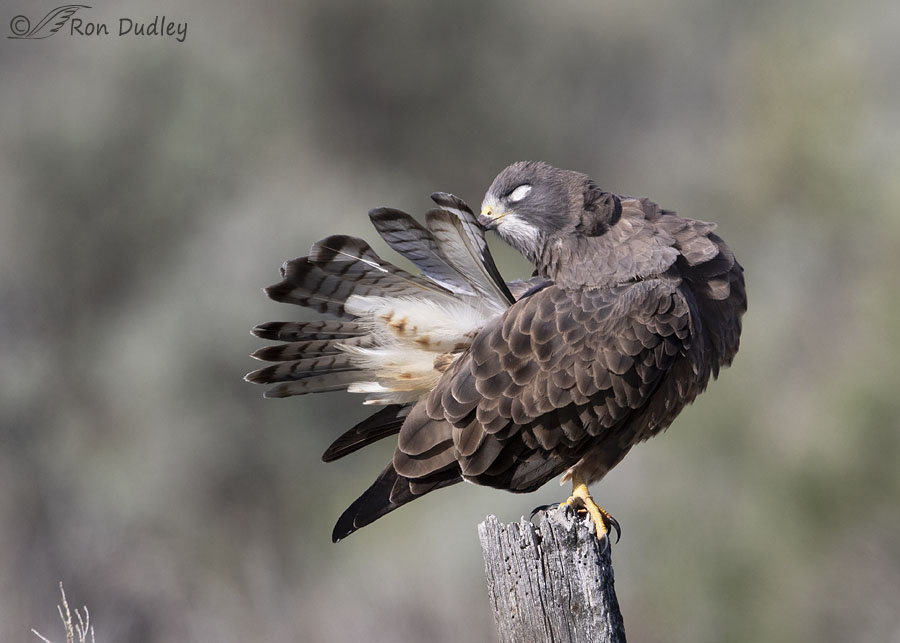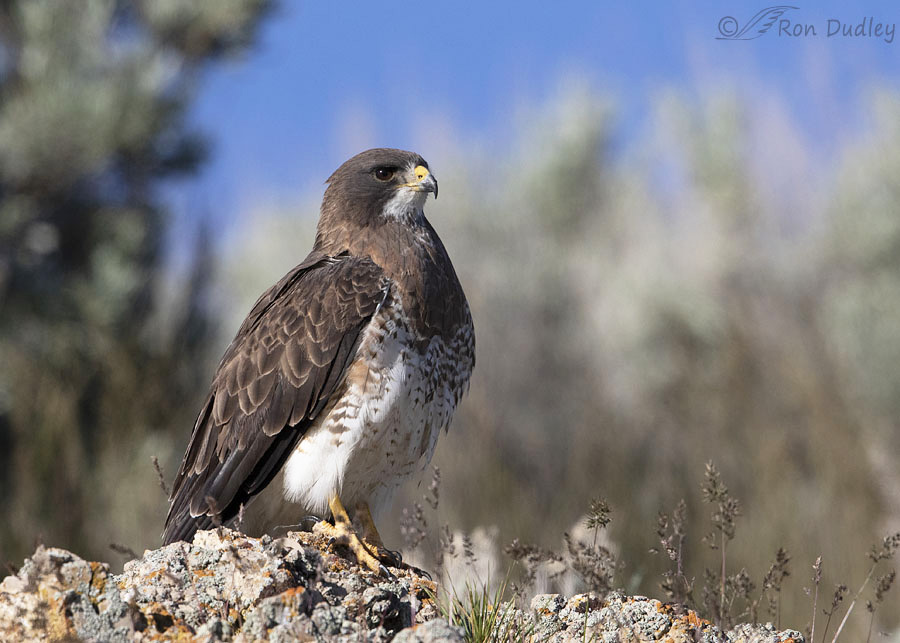An intermediate morph and a light morph.
I photographed both birds three years ago but it’s that time of year for Swainson’s Hawks to show up again so they’ve been on my mind.

1/2500, f/6.3, ISO 500, Canon 7D Mark II, Canon EF 500mm f/4L IS II USM + EF 1.4 III Extender, not baited, set up or called in
This bird, an intermediate morph, was hunting fearlessly from a very old fence post near the road even as the occasional vehicle whizzed by. I’m drawn to “his” alert pose in particular. But when his search for prey proved fruitless for an extended period his demeanor transformed from alert to…

1/2000, f/6.3, ISO 500, Canon 7D Mark II, Canon EF 500mm f/4L IS II USM + EF 1.4 III Extender, not baited, set up or called in
extremely relaxed as he began to preen his tail.
Typically when raptors do this they close their transparent nictitating membrane to protect their eye but this bird chose to close his actual eyelid instead. His almost white eyelid contrasts strongly with the surrounding darker plumage around his eye which reminded me of magpies flashing their white membranes for purposes of communication.
I actually find the effect interesting. He kept his eyelid closed for an extended period while he groomed his tail – long enough for me to get many photos that show the white eyelid closed (no, that eye wasn’t injured).

1/4000, f/6.3, ISO 500, Canon 7D Mark II, Canon EF 500mm f/4L IS II USM + EF 1.4 III Extender, not baited, set up or called in
And this much different looking bird is a light morph Swainson’s Hawk, photographed several weeks later in the same general area. In contrast to the previous hawk I actually know this bird to be a male because he was paired up and I photographed him mating.
I like this photo for its natural setting and varying colors in the bird, background and perch. And I think the partial sidelight contributes to the appeal of the image although I do wish we could see his tail and wingtips.
Swainson’s Hawks migrate annually between their breeding grounds in North America and their wintering areas in the pampas of South America, Argentina in particular. They migrate in flocks than can be as large as 10,000 birds and the round trip exceeds 12,000 miles, a distance second among raptors only to the migration distance of the Arctic Peregrine Falcon. Since they’re gone from northern Utah for over six months I always look forward to their return with great anticipation.
Knowing what’s going on in South America these days maybe they left a little early this year…
Ron


I thought “what??? they are already in Utah???” Then I read the captions. I’ve overwintered a Swainson’s in rehab. She was too ill to release at migration time last fall. Now she’s ready to go, so we’re watching the skies to see when they show up here. I’ll miss her, but she won’t miss me! I am so privileged to be able to help. Your photos are part of my morning ritual. Ron, thank you for sharing your work and your thoughts.
Ron, you a right. These hawks are certainly handsome and regal. I’ll have to check out Magpies using their eyes to communicate.
Is the 6 weeks up since you had your surgery? I forgot to track………
Thank you, Ron
Thanks, Alice. Pretty soon…
Beautiful birds. Their color variations are interesting. I hope they have a good year in Utah. So far they seem able to find more habitats as farming fields turn into subdivisions.
They seem to really like irrigated fields so I hope you’re right about subdivisions. Thanks, April.
Beautiful!
Grab ahold of a tail feather and close my eyes while I run it through my bill.
Wonderful images of a gorgeous species!
Thanks for sharing.
Thank you, Dick.
That preening shot is great — love that he seems to be so into it! The pop of blue sky over the light morph’s head adds to that “regal raptor” look. It makes me feel like he’s posed specifically for that portrait.
The pop of blue sky over the light morph’s head adds to that “regal raptor” look. It makes me feel like he’s posed specifically for that portrait.
Thank you, Marty. I agree that the blue sky adds a lot to the photo.
Hi Ron,
“Handsome Swainson’s Hawks” is, in my view, a redundant term!
Like you, I am awaiting their return. And, FYI, I heard the observers at the Anza-Borrego hawkwatch experienced an earlier than usual first trickle of Swaainson’s Hawk migrants this year. Good news!
Cheers,
Dick
You’re right about the redundancy, Dick. I think all three color morphs are handsome.
And thanks for that migration report.
Beautiful photos, especially the first one. Love the pose. Certainly is a beautiful bird and probably one I’ll not ever see in my area. The differences between the light and intermediate morph is astounding…and then the rufous morph is the prize! So much to see and learn. Don’t you just envy people who spend their lifetime with raptors! How fortunate they are. Question…visually are they comparable in size to a Rough-Legged or smaller?
Thanks, Kathy. To my knowledge there’s no rufous morph Swainson’s Hawk. The rufous I’ve been posting is a red-tail.
Rough-legged Hawks are slightly larger than Swainson’s, both in wingspan and in weight.
‘Birds of North America’ (Cornell) has photos labeled as such…I went back to check (appearance page) and perhaps they fall into the overall category of intermediate occurring at a higher frequency in the Central Valley of CA. Their descriptions are so detailed right down to the year of age. At any rate they do say Swainson’s is one of the most variably plumaged raptors in the world! Given that and what they say, the ordinary person like me just is content to say ‘ WOW what a beauty!’
Very handsome birds Ron. I especially like that last one in the natural setting. I have never seen a Swainson. Possibly they are here from time to time, but very rare. Hope the back is well.
Everett Sanborn, Prescott AZ
I think they are in your area but possibly only in small numbers, Everett. Thanks.
We’re pretty sure we saw one just above Jerome last June, Everett.
Beautiful birds, Ron…….. The intermediate morph certainly wasn’t concerned about anything bothering it to close it’s eye in that way! The light morph looks like a totally different bird. No wonder sorting out “what” they are is confusing. I was unaware of magpies using their eyes for communications…. – don’t know what they’re doing next wise at the moment – dome “gone” on one and, appears they are also trying to dismantle the dome on another. Still enough snow in the yard I haven’t seen where they are going with the materials…..
The intermediate morph certainly wasn’t concerned about anything bothering it to close it’s eye in that way! The light morph looks like a totally different bird. No wonder sorting out “what” they are is confusing. I was unaware of magpies using their eyes for communications…. – don’t know what they’re doing next wise at the moment – dome “gone” on one and, appears they are also trying to dismantle the dome on another. Still enough snow in the yard I haven’t seen where they are going with the materials….. 
“No wonder sorting out “what” they are is confusing”
And then there’s the dark morph to add to the confusion!
I’ve also seen magpies appear to “change their minds” about a nest they’re building or refurbishing. In one case I wondered if it was because the bush the old nest was in was dead so the leaves weren’t coming out to disguise the nest. Just a guess on my part…